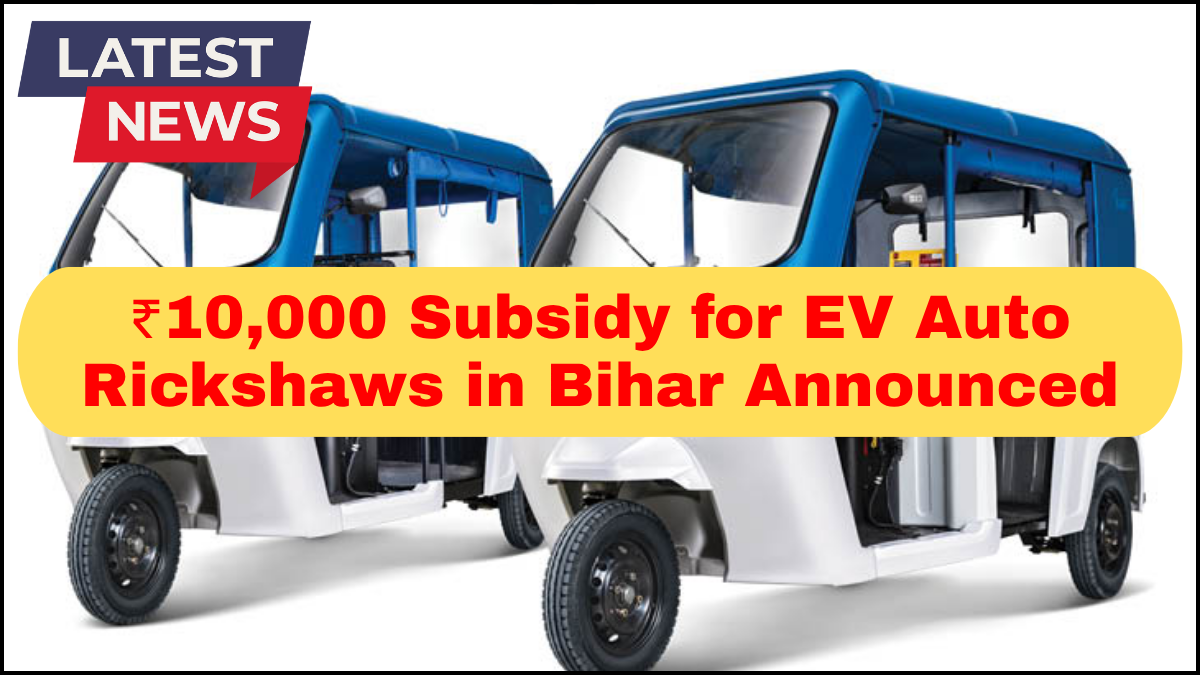The Government of Bihar has announced a ₹10,000 subsidy for electric auto rickshaws, signaling a major step toward sustainable urban mobility. This EV auto rickshaw subsidy in Bihar is part of a larger push to promote green transport incentives and reduce the state’s reliance on fossil fuel-based public transport systems.

Why the Subsidy Matters
Bihar, with its growing urban population and increasing demand for affordable transport, faces mounting environmental concerns. Traditional auto rickshaws running on diesel and petrol contribute significantly to urban air pollution. The ₹10,000 subsidy is aimed at accelerating the shift to electric vehicles (EVs) and offering financial relief to auto drivers and small transport operators looking to make the switch.
This move aligns with the broader national goals under the Faster Adoption and Manufacturing of Hybrid and Electric Vehicles (FAME) initiative and supports Bihar’s state-specific electric mobility roadmap.
Who Can Avail the Subsidy?
The subsidy is available to individuals and fleet operators who purchase new electric auto rickshaws registered in Bihar. This incentive applies to both passenger and goods-carrying electric rickshaws.
To qualify, the vehicle must:
-
Be a government-approved electric model
-
Be registered within Bihar
-
Meet safety and efficiency standards set by the Ministry of Road Transport
Applicants will also need to provide proof of purchase and vehicle registration to claim the benefit. The subsidy will be transferred directly into the beneficiary’s bank account through the Direct Benefit Transfer (DBT) mechanism.
Supporting the Green Transport Incentive Drive
This subsidy is not a standalone initiative. It is part of a larger green transport incentive strategy aimed at:
-
Reducing air and noise pollution in cities like Patna, Gaya, and Muzaffarpur
-
Lowering operating costs for drivers, as electric vehicles are far cheaper to run and maintain
-
Boosting job creation in the EV servicing and charging infrastructure sectors
By subsidizing EV auto rickshaws, the Bihar government aims to establish a cleaner, quieter, and more cost-effective public transport ecosystem. This is expected to be especially beneficial for urban and peri-urban areas where auto rickshaws are the backbone of last-mile connectivity.
Cost Savings and Long-Term Benefits
The upfront subsidy of ₹10,000 might seem modest, but when combined with lower fuel costs, minimal maintenance needs, and central subsidies under FAME-II, the financial advantages stack up significantly for buyers.
For instance, an electric auto owner can save up to ₹40,000–₹50,000 annually compared to a petrol variant due to cheaper running costs. Over 5 years, this translates to savings that exceed ₹2.5 lakh—a substantial sum for any small transport entrepreneur.
Moreover, the operational efficiency of EVs allows for more trips per day without the need for refueling, leading to increased earnings.
Infrastructure Development for EVs
Recognizing that financial subsidies alone won’t drive adoption, the Bihar government is also investing in EV infrastructure:
-
Charging stations are being installed across major transit hubs.
-
Public-private partnerships are being encouraged to expand charging and service networks.
-
Workshops and training centers are being set up to train mechanics and service professionals on EV maintenance.
These complementary efforts ensure that the transition to electric mobility is practical, not just aspirational.
Challenges Ahead
Despite the benefits, some challenges remain:
-
Limited awareness among drivers about available subsidies
-
Initial price of EV autos still being higher than conventional ones (despite long-term savings)
-
Inconsistent availability of spare parts and maintenance services in rural areas
Addressing these hurdles through awareness campaigns, easier financing options, and better infrastructure will be critical to the long-term success of Bihar’s EV auto rickshaw subsidies program.
FAQs
Q1: Who is eligible for the ₹10,000 EV auto rickshaw subsidy in Bihar?
Any resident or fleet operator in Bihar purchasing a new, government-approved electric auto rickshaw is eligible, provided the vehicle is registered within the state.
Q2: How can I apply for the subsidy?
Applicants need to submit the vehicle registration and proof of purchase. The subsidy will be disbursed through Direct Benefit Transfer (DBT) into the applicant’s bank account.
Q3: Can this subsidy be combined with central government incentives?
Yes, this subsidy can be availed along with central incentives under the FAME-II scheme, reducing the total cost of ownership even further.
Q4: Are charging stations available across Bihar?
Charging stations are currently being rolled out in urban centers, and expansion to more districts is underway as part of the EV policy roadmap.
Q5: What are the environmental benefits of EV auto rickshaws?
They produce zero tailpipe emissions, reduce noise pollution, and significantly cut down urban air pollutants compared to diesel or petrol rickshaws.
click here to learn more